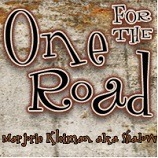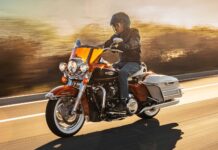The International Motorcycle Show series is currently making across the U.S., bringing with it ancillary industry events and meet-ups in various cities. This year, Women in Powersports, a professional network for women in the powersports industry, hosted mixers the night before the show opened in Long Beach, California, as well as New York City. The NYC edition was held at the factory showroom of Breaking Hearts & Burning Rubber, a company that manufactures women’s motorcycle boots.
I’d first heard of this company when it was part of the new Shift at IMS exhibit in December 2017. I thought the boots were nice and looked to be of high quality, but I hadn’t given the footwear, or the company, another thought in the year since then… until the night of the mixer, that is, when BH&BR founder/owner Leslie Padoll took us on a tour of her factory.
Leslie rides a Harley-Davidson, and always found it a challenge to find the perfect balance between form and function. As many of us women have observed, women’s riding boots are generally either quite fashionable but not up to the rigors of hard riding, or highly functional and, well, ugly. So Leslie set out to change that, using her work in the fashion industry to come up with styles that appealed to her and translate them into boots that would still perform well on a bike.
Everything is made to order in the BH&BR factory, right in the heart of New York City’s garment district. Besides admiring the beautiful, classy, yet practical styles she’s produced, I marveled at how this young woman learned pretty much everything there is to know about footwear design and manufacturing, from hiring the best craftsmen to finding the tools, equipment and machinery best suited for the job. The company launched its first three boot styles in 2015, and they were immediate hits, allowing Leslie to expand her operations as well as her reach in both the motorcycle and fashion industries.
Hearing Leslie describe the challenges she faced (and eventually overcame) brought to mind another business, Genuine Motorworks, that was started nearly 10 years ago in Brooklyn, New York. According to their website, Genuine Motorworks is “dedicated to showcasing American-made products by the artistic people who understand quality and craftsmanship.” I was privileged to be present when the business celebrated its fifth anniversary in early 2014, when founder and owner Elisa Seeger asked me, “Did you know that 30 years ago, 98 percent of our clothing was made here [in the U.S.], and now that number is only two percent?”
I was shocked by that number. I knew that a lot of U.S. shoe and clothing companies had been shifting their manufacturing offshore gradually since the mid-20th century, but I hadn’t realized to what extent. I did know some of the reasons why, such as China and other low-wage countries were developing cheap manufacturing methods using cheaper materials. And then, although the passage of the North American Free Trade Agreement (NAFTA) in 1994 brought many benefits to the global economy, it started to make less and less financial sense for retailers to produce or purchase clothing made in the U.S.
Of course this mass exodus of manufacturing away from our shores isn’t just confined to the apparel industry; it has hit nearly every other industry as well. Although we are fortunate to have many talented designers, artisans, and craftspeople creating motorcycle components, accessories and apparel here in the U.S., cheap products manufactured in certain other countries continue to be a major problem for consumers, those U.S. workers whose jobs have been lost, and the American companies whose parts are being knocked off.
Although NAFTA and cheap overseas labor and materials certainly accounted for the bulk of manufacturing to be offshored, our lack of formal apprentice programs could be another cause. Certain trades as well as some crafts do offer apprenticeships (think of your local tattoo shop or independent motorcycle shop), but these programs can be few and far between. And there are many highly-skilled artisans that are not interested in passing down their skills which stand a chance of being lost forever once their generation passes on. Overall, our apprenticeship programs pale considerably when compared to those in Europe, adding further to the dearth of skills in the U.S., as did automation and the inconsistent application of governmental assistance to boost private-sector industry jobs.
However, in just this century, there’s been a groundswell of “reshoring,” or bringing back manufacturing to the U.S., as well as ramping up the number of apprenticeships available. Other efforts include programs such as the mikeroweWORKS Foundation (remember Mike Rowe of Dirty Jobs and Somebody’s Gotta Do It fame?), a 501(c)(3) public charity that gets people trained for skilled jobs through scholarship programs.
Will the U.S. ever see manufacturing return to its peak experienced in the late 1970s? Probably not in our lifetimes, if ever. But there are still businesses that conduct all aspects of their operations here in the U.S.—companies like BAKER Drivetrain and S&S Cycle come to mind. “Made in the U.S.A.” is no longer just a cliché for aging boomers that remember when you could go to Sears to buy American-made tools or purchase a pair of jeans that were made here in the 48 states. I know that when possible, I’d prefer to support American craftspeople. Even if I have to pay a little more for products, I’d like to see people and their families with roots in our communities thrive, and we can once again take pride in American craftsmanship.




















